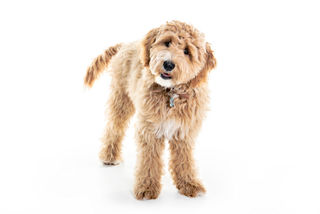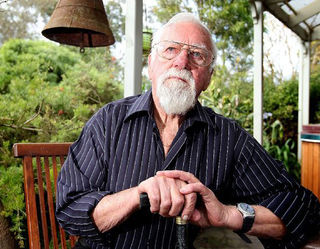Ethics and Morality
A Designer Dog-Maker Regrets His Creation
The inventor of the Labradoodle believes he created a Frankenstein.
Posted April 1, 2014 Reviewed by Lybi Ma

I was in the lobby of a hotel in Toronto waiting to be picked up and taken to the venue where I was scheduled to give a talk. A well-dressed middle-aged woman was standing nearby with a sand-colored curly-haired dog. As I bent down to give the dog a friendly pat, she announced to me, "Molly is a purebred Labradoodle, just like the one Jennifer Aniston has."
It amazes me how intelligent people can refer to an intentionally crossbred dog, such as the Labradoodle, as "purebred." The Labradoodle is a cross between the Labrador Retriever and the Poodle. It avoids the negative label of "mutt" or "mongrel" because it is a deliberate crossbreeding, and those who market such pups have come to refer to them as "designer dogs," a label that gives them a hint of sophistication and elitism. There are many designer dogs now available and the majority involve crossbreeding Poodles with other breeds.
Perhaps the earliest of these appeared in the 1950s, and it was the Cockapoo, a Cocker Spaniel-Poodle cross, which never achieved much popularity. Nowadays, one can find a Goldendoodle (Golden Retriever/Poodle), Schnoodle (Miniature Schnauzer/Poodle), Cavoodles (Cavalier King Charles Spaniel/Poodle), Roodles (Rottweiller/Poodle), Yorkiepoo (Yorkshire Terrier/Poodle), Shihpoo (Shih Tzu/Poodle), Maltipoo (Maltese/Poodle), Poochon (Bichon Frise/Poodle), Lhasapoo (Lhasa Apso/Poodle) to name a few.
Although there are other designer dog crosses, the Poodle is frequently entered into the mix to provide a non-shedding coat quality and a presumed hypoallergenic trait to the resultant pups.

I was fortunate enough to be able to interview Wally Conron a few years ago—the very man credited with the creation of the Labradoodle. Conron was the puppy breeding manager for the Royal Guide Dog Association of Australia in the 1980s when his boss set him a difficult task.
A blind woman from Hawaii had written to ask if they could provide a guide dog that would not shed hair because her husband was allergic to it. To quote Conron, "I said, 'Oh yes, this will be a piece of cake. The Standard Poodle is a working dog; it doesn't shed hair so it'll be great.' I tried 33 dogs in the course of three years and they all failed. They just didn't make the grade as guide dogs. Meanwhile, the woman in Hawaii was getting older and my boss was getting on my back."
Desperation drove Conron to consider an alternate course of action. The upshot was that he took his best female Labrador Retriever and mated it with a Standard Poodle. This resulted in a litter of three pups. With a long waiting list for people wishing to foster guide dog puppies, Conron was sure that he'd have no problem placing their three new crossbred dogs with a family to be trained and socialized before being enlisted in the guide dog program.
Unfortunately, nobody would take them since everyone wanted a purebred dog. So that's when Conron came up with the name Labradoodle. According to him, "I went to our PR team and said, 'Go to the press and tell them we've invented a new dog, the Labradoodle.' It was a gimmick, and it went worldwide. It worked—during the weeks that followed, our switchboard was inundated with calls from potential dog fostering homes, other guide-dog centers, vision-impaired people and people allergic to dog hair who wanted to know more about this 'wonder dog.'"
Conron immediately discovered that since the Labradoodle is a hybrid and not a pure breed, the resulting puppies did not have consistently predictable characteristics. Although all Labradoodles have some common traits, their appearance, working-ability, and behavioral characteristics remain somewhat unpredictable. Even in the nature of their coat—the reason why the Poodle was originally part of the mix—there are variabilities. Labradoodles' coats can vary from wiry to soft, and they may be curly, wavy, or straight. Straight-coated Labradoodles are said to have "hair" coats, wavy-coated dogs have "fleece" coats, and curly-coated dogs have "wool" coats.
Many Labradoodles do shed, although the coat usually sheds less and has less dog odor than that of a Labrador Retriever. In the Labradoodle, there is also no certainty that the dog will be hypoallergenic. Conrad explains that the raison d'être for having these crosses in the first place was to prevent allergy symptoms, and that characteristic cannot be guaranteed by simply creating a Poodle cross.
He complains, "This is what gets up my nose if you'll pardon the expression. When the pups were 5-months-old, we sent clippings and saliva over to Hawaii to be tested with this woman's husband. Of the three pups, he was not allergic to one of them. In the next litter I had, there were 10 pups, but only three had non-allergenic coats. Now, people are breeding these dogs and selling them as non-allergenic, and they're not even testing them!"
He continues his lament, "Get on the Internet and verify it for yourself. All these backyard breeders have jumped on the bandwagon, and they're crossing any kind of dog with a poodle. They're selling them for more than a purebred is worth and they're not going into the backgrounds of the parents of the dogs. There are so many poodle crosses having fits, problems with their eyes, hips, and elbows, and a lot have epilepsy. There are a few ethical breeders, but very very few.
"I opened a Pandora's box, that's what I did. I released a Frankenstein. So many people are just breeding for the money. So many of these dogs have physical problems, and a lot of them are just crazy.
"You know that American president Obama announced he was thinking of getting a Labradoodle. So I wrote him a letter saying what the pitfalls were. I said 'If you are going to buy a Labradoodle, check both of the parents, make sure they have a certificate. A lot of them are untrainable, and a lot of them are no good for people with allergies.' I don't know if he was listening to me but he didn't get one in the end.
"Today I am internationally credited as the first person to breed the Labradoodle. People ask me 'Aren't you proud of yourself?' I tell them 'No! Not in the slightest.' I've done so much harm to pure breeding and made many charlatans quite rich. I wonder, in my retirement, whether we bred a designer dog—or a disaster!"
And has he ever kept a Labradoodle as a pet?
"No way!" He told me in a shocked tone of voice. "My dogs are Labrador Retrievers—Rocky and Jazz. I only ever bred 31 Labradoodles. I'm on a pension and live in a little shoebox flat. If I'd gone into breeding Labradoodles for a living, I'd be on easy street. But there was no way I'd do it. My conscience wouldn't let me."
Stanley Coren is the author of books including The Wisdom of Dogs; Do Dogs Dream? Born to Bark; The Modern Dog.
Copyright SC Psychological Enterprises Ltd. May not be reprinted or reposted without permission




